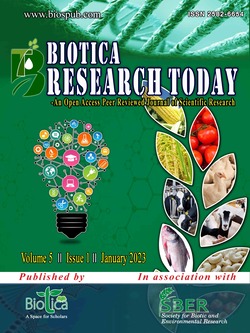
Biofloc Technology: Innovative Approach towards Sustainable Aquaculture
Niti Sharma
ICAR-Central Inland Fisheries Research Institute, Regional Centre, Guwahati, Assam (781 006), India
Bijit Bania
College of Fisheries, Assam Agricultural University, Raha, Nagaon, Assam (782 103), India
Amulya Kakati
ICAR-Central Inland Fisheries Research Institute, Regional Centre, Guwahati, Assam (781 006), India
Pronob Das*
ICAR-Central Inland Fisheries Research Institute, Regional Centre, Guwahati, Assam (781 006), India
DOI: NIL
Keywords: Aquaculture, Biofloc, Fish culture, Sustainability
Abstract
Biofloc technology (BFT) is an eco-friendly aquaculture approach that allows continuous recycling and reuse of nutrients in the system and reduces water exchange while providing added value resulting from microbial metabolism. The BFT system is a cutting-edge method of fish culture that is mostly used for shrimp and tilapia in India. Over time, as more people became aware of the technique, many other fish species were successfully produced in the system. BFT is one of the best system in today scenario as it help in reducing high operational cost, cost of land use, high cost of feed and discharge and disposal of waste sludge, thus minimizing water pollution. It also reduces the spread of pathogens and also improves fish health. In this article, we have given an overview of Biofloc system, fish species cultured in the system and a pilot study is also discussed.
Downloads
not found
Reference
Avnimelech, Y., 1999. Carbon/nitrogen ratio as a control element in aquaculture systems. Aquaculture 176, 227-235.
Avnimelech, Y., 2009. Biofloc Technology - A Practical Guide Book. The World Aquaculture Society, Baton Rouge, Louisiana, United States. p. 182.
Crab, R., Avnimelech, Y., Defoirdt, T., Bossier, P., Verstraete, W., 2007. Nitrogen removal techniques in aquaculture for a sustainable production. Aquaculture 270, 1-14.
Crab, R., Defoirdt, T., Bossier, P., Verstraete, W., 2012. Biofloc technology in aquaculture: beneficial effects and future challenges. Aquaculture 356, 351-356.
Schneider, O., Sereti, V., Eding, E.H., Verreth, J.A., 2006. Molasses as C source for heterotrophic bacteria production on solid fish waste. Aquaculture 261(4), 1239-1248.
